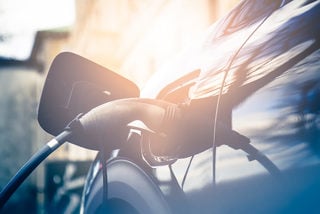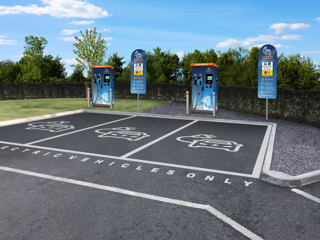Government-funded and commercial-backed ventures are seeking to identify solutions to some of the most pressing concerns around electric vehicle charging infrastructure.
The Government set aside £40m as part of its Road to Zero strategy for two charging competitions: one to develop and trial low-cost wireless for back-to-base fleets, the other for on-street charging technology for the third of UK homes without off-street parking.
Wireless charging options are being assessed by 14 programmes, while 16 projects are looking at public charging solutions for urban environments.
Among these are local charging hubs, for example at shopping centres and cinemas, transport hubs and street-side parking.
The Department for Transport, which has factored in a 10% reduction in vehicle use by 2030 to hit its emissions targets, has also allocated £30m to a vehicle-to-grid (V2G) programme with20 projects taking place over the next couple of years.
Mark Thompson, head of energy at Innovate UK, the non-governmental public body, told the Energy Saving Trust Fleet Heroes conference: “We expect many of these to become business as usual.”
He believes that speed of uptake for electric vehicles will depend on “diversity”, with key drivers including patterns of use, battery size and urban circumstances.
“There is no silver bullet; diversity is the way of the future,” Thompson said. “If you want a car to charge as quickly as refuelling, yes that will come but it will be more expensive.
"But if you want rewards for helping the grid and to keep your costs down, you want to be plugged in all the time to maximise the opportunities.”
He dismissed naysayers who claimed the grid would not have capacity to charge millions of EVs, pointing to the diversity of work charging, smart charging (such as solar panels) and vehicle-to-grid charging.
The public infrastructure received a boost this month with the announcement of a joint venture between Volkswagen and Tesco to introduce more than 2,400 EV charging bays across 600 stores nationwide within three years.
Powered by Pod Point, the bays will offer free 7kW charging or use of a 50kW rapid charger for a small fee based on market rates.
Critics pointed out that the agreement amounted to just four charge points on average at each site, but it still represents a 14% increase in the number of public charge bays in the UK.
Thompson said the UK needed a portfolio of solutions that matched different lifestyles: “Airports, for example, could be ideal for V2G – it could be high value for both parties with discounted parking.”
However, as batteries increase in size and range increases, people might only need to charge once or twice a week, reducing demand on the infrastructure.
In what is being described as the world’s biggest electric vehicle trial, Royal Mail, Centrica and Uber are to run 3,000 electric vehicles over the next three years, helping to test Thompson’s theory that grid capacity will not be an issue.
Optimise Prime is a three-year project involving UK Power Networks and data business Hitachi Vantara, supported by SSE and Hitachi Capital Vehicle Solutions. It will test and implement the best options for EV rollout for commercial operators.
Funding of £16.6 million will come from Ofgem, with £18m from the project partners.
The project will identify practical ways of overcoming the infrastructure concerns that are one of the biggest barriers to success, according to Paul Gatti, Royal Mail fleet director.
“When deploying our first 100 vans, one of the key factors guiding the decisions was grid resilience,” he said. “For tackling air pollution it is essential that electric vehicles are deployed in areas with the worst air quality, rather than areas with the best connections to the electricity grid.”
Gatti added: “Electric vehicles will play a key focus for our business moving forward, alongside a programme of initiatives that will ensure we can deliver letters and parcels efficiently and in as eco-friendly manner as possible.”
Ian Cameron, UK Power Networks head of innovation, told Fleet Heroes delegates that Optimise Prime would “develop solutions to enable fleets to charge at home, depot or en route with least disruption”.
He forecast that the number of plug-in vehicles across the UK Power Networks region would rise from 55,000 today to more than four million by 2030, with 70% of charging taking place at home, 20% at work and 10% while travelling.
Local grid capacity is an issue, but could be resolved by utilising flexible (smart charging/discharging) and smart connection (timed/profiled, which give a power boost outside of peak hours) solutions rather than private companies funding extra substation/transformers.
Electrification is “a business priority” for Centrica, but comes with a number of hurdles, including range and cost of ownership.
Steve Winter, head of fleet at Centrica, said: “Optimise Prime offers us the chance to test the electrification of our fleet at some scale in the context of other new technologies to try and not only make the business case more attractive but also leverage learning from EV infrastructure management.”
This could include the use of “bespoke commercial arrangements” with other businesses to use their EV charging infrastructure as part of route planning, and load shifting to relieve network constraints at peak times while maintaining operational cover, he explained.
Optimise Prime will launch in early 2019 with the first electric vehicles on the road during the second half of the year. The test area will include urban, suburban and rural scenarios across the south and east of England.






















Login to comment
Comments
No comments have been made yet.